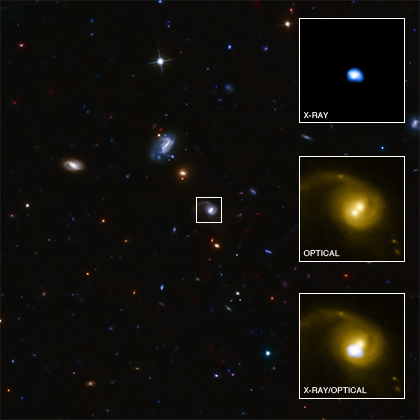The Science of Black Hole Kicks: An Interview with Avi Loeb

For more context on CID-42 and the science of black hole kicks, we interviewed Professor Abraham (Avi) Loeb, one of the co-authors of the new paper. Avi is the director of the Institute for Theory and Computation, within the Harvard-Smithsonian Center for Astrophysics, and he is currently serving as Chair of the Department of Astronomy at Harvard University. He was recently elected to become a member of the American Academy of Arts & Sciences. Avi has worked on a wide variety of topics in astrophysics, including cosmology, black holes, gravitational lensing by planets and gamma-ray bursts in the distant Universe.
Q: How significant do you think this result is?
A: CID-42 is the best candidate for a massive black hole that might have been kicked out of the center of a galaxy with a high speed. An interesting mechanism for obtaining such a kick involves the merger of two black holes into the kicked black hole.
Almost a century ago, Albert Einstein formulated the modern set of equations that are used to describe gravity. Einstein's equations are so complicated that we were able to solve them accurately only a few years ago for a relatively simple system of two black holes in a bound orbit. Such a system forms naturally as a result of a merger between two galaxies, each hosting a single black hole at its center. The exact solution to Einstein's equations, obtained with sophisticated computer algorithms, shows that the two black holes merge into a single black hole which is kicked in a preferred direction like a rocket due to the directional emission of gravitational waves which serve as the substance coming out from the rocket exhaust.
If CID-42 was indeed produced by this mechanism, it provides the first observational validation of Einstein's equations in the unexplored regime of dynamical strong gravity, which is responsible for gravitational wave kicks.
Q: There have been a few other candidates for black holes ejected from galaxies by gravitational waves. How does this one stand out from the others?
A: CID-42 is the strongest candidate for such a recoiled black hole because the active black hole is offset from the center of the galaxy in both position and velocity. No other system shows these offsets so clearly.
Q: Please explain how gravitational radiation can impart a kick to a black hole after a merger. Why has it only been recently that very powerful kicks -- enough to throw the black hole out of the galaxy -- have been predicted?
A: Astrophysical black holes are characterized by two numbers: mass and spin. If the merging black holes have no spin, the recoil speed of the remnant black hole is modest, limited to 200 kilometers per second. Such an ejection speed would not allow the black hole at the center of the Milky Way galaxy to escape. However, if the merging black holes have spins, the kick velocity could reach thousands of kilometers per second for special spin orientations. Only recently were researchers able to solve Einstein's equations for binary black hole systems with all possible spin configurations.
Q: How common are black hole pairs and mergers likely to be in the local universe and in the early universe?
A: A galaxy like the Milky Way has a sizeable chance to merge with a comparable-mass galaxy, like its neighbor Andromeda galaxy, during the past ten billion years. In the early universe, mergers of galaxies were more common since the Universe was denser and they were closer to each other. In fact, a galaxy like the Milky Way was assembled out of many mergers of smaller building blacks at early cosmic time. The formation of black hole binaries and gravitational wave emission was a common phenomenon at these early times. Astronomers proposed a space-based observatory for these gravitational waves, called the Laser Interferometer Space Antenna (LISA), which is not funded yet. If funded, this observatory will open a new window into the early history of black hole formation in the Universe.
Q: As we wait for the first direct detection of gravitational waves how useful might studies of systems like CID-42 be for understanding gravitational waves?
A: Until the LISA observatory is funded, we have to rely on detecting electromagnetic waves (using ordinary telescopes) from systems such as CID-42, as a test of Einstein's theory of gravity.
Q: If black holes are important for the evolution of galaxies, then how might the eviction of a merged black hole make a difference to the evolution of its former host galaxy?
A: Indeed, the ejection of black holes from galaxy centers could affect the evolution of their host galaxies. However, large kicks of the magnitude associated with CID-42 must be rare, since we do not know of many such examples.
|
The Fate of Milkomeda’s Black Hole and More About CID-42 Here, we include some extra background information about the CID-42 result, beginning with projections for the fate of the supermassive black hole that will be created when the Milky Way merges with the Andromeda (M31) galaxy to form “Milkomeda” in about four billion years (http://lanl.arxiv.org/abs/1205.6865). Thanks to Laura Blecha of CfA for helping with this information. - A merger between the supermassive black hole in the Milky Way and the one in Andromeda will be a dramatic event, but it is unlikely to result in the eviction of the newly formed black hole. According to the latest theoretical work, only in mergers where the masses of the two black holes are close to each other is there a good chance that a strong kick will be given to the black hole. In numerical terms, by “close” we mean the ratio between the masses of the two black holes is less than about ten. For the simulation of the merger forming CID-42, the mass ratio is close to one, but in the case of the Milky Way and Andromeda black holes the masses are much less evenly matched. The mass of the Milky Way's supermassive black hole is estimated to be about 4.5 million times the mass of the sun (http://arxiv.org/abs/0810.4674 & http://arxiv.org/abs/0808.2870) and the mass of Andromeda's black hole is estimated to be about 140 million times the mass of the Sun (http://arxiv.org/abs/astro-ph/0509839), giving a mass ratio of more than 30. So, unless the black hole weight estimates contain significant errors, or there are serious problems with the theory, Milkomeda is going to keep its supermassive black hole when it forms. - The kinetic energy of a black hole as massive as CID-42 moving at three million miles per hour is enormous. Its energy is equivalent to the energy produced by about 200,000 supernova explosions. - Recoil speeds for supermassive black holes of more than ten milion miles per hour have been predicted by theoretical work. For the largest recoil speeds the mass ratio should equal one and the spin of the black holes should be partially aligned with the plane of their orbit before merging (http://arxiv.org/abs/1108.2009). - Under the right conditions, the new black hole can have a much smaller mass than the combined masses of the two original black holes. Simulations incorporating General Relativity have shown that the energy emitted in gravitational waves by the merger of two massive black holes can be equivalent (using E=mc2) to as much as ten per cent of the masses of the black holes before they merged. Peter Edmonds |
Category:
- Log in to post comments

